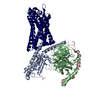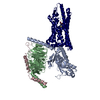[English] 日本語
 Yorodumi
Yorodumi- PDB-7wvy: Cryo-EM structure of the human formyl peptide receptor 2 in compl... -
+ Open data
Open data
- Basic information
Basic information
| Entry | Database: PDB / ID: 7wvy | ||||||||||||
|---|---|---|---|---|---|---|---|---|---|---|---|---|---|
| Title | Cryo-EM structure of the human formyl peptide receptor 2 in complex with Abeta42 and Gi2 | ||||||||||||
 Components Components |
| ||||||||||||
 Keywords Keywords | SIGNALING PROTEIN / G protein-coupled receptor / formyl peptide receptor / FPR2 / Abeta42 | ||||||||||||
| Function / homology |  Function and homology information Function and homology informationN-formyl peptide receptor activity / complement receptor activity / immune response-regulating cell surface receptor signaling pathway / negative regulation of adenylate cyclase-activating adrenergic receptor signaling pathway / scavenger receptor binding / RAGE receptor binding / negative regulation of calcium ion-dependent exocytosis / G protein-coupled adenosine receptor signaling pathway / negative regulation of adenylate cyclase activity / positive regulation of urine volume ...N-formyl peptide receptor activity / complement receptor activity / immune response-regulating cell surface receptor signaling pathway / negative regulation of adenylate cyclase-activating adrenergic receptor signaling pathway / scavenger receptor binding / RAGE receptor binding / negative regulation of calcium ion-dependent exocytosis / G protein-coupled adenosine receptor signaling pathway / negative regulation of adenylate cyclase activity / positive regulation of urine volume / complement receptor mediated signaling pathway / positive regulation of neural precursor cell proliferation / positive regulation of monocyte chemotaxis / positive regulation of innate immune response / negative regulation of synaptic transmission / Formyl peptide receptors bind formyl peptides and many other ligands / cargo receptor activity / positive chemotaxis / gamma-aminobutyric acid signaling pathway / regulation of calcium ion transport / tertiary granule membrane / ficolin-1-rich granule membrane / negative regulation of apoptotic signaling pathway / neuronal dense core vesicle / specific granule membrane / positive regulation of vascular associated smooth muscle cell proliferation / positive regulation of superoxide anion generation / Adenylate cyclase inhibitory pathway / clathrin-coated pit / response to nutrient / astrocyte activation / receptor-mediated endocytosis / positive regulation of phagocytosis / hippocampal mossy fiber to CA3 synapse / Regulation of insulin secretion / serine-type endopeptidase inhibitor activity / calcium-mediated signaling / microglial cell activation / electron transport chain / G protein-coupled receptor binding / G protein-coupled receptor activity / adenylate cyclase-inhibiting G protein-coupled receptor signaling pathway / negative regulation of inflammatory response / G-protein beta/gamma-subunit complex binding / endocytosis / Olfactory Signaling Pathway / cellular response to amyloid-beta / adenylate cyclase-activating G protein-coupled receptor signaling pathway / Activation of the phototransduction cascade / chemotaxis / G beta:gamma signalling through PLC beta / Presynaptic function of Kainate receptors / Thromboxane signalling through TP receptor / G protein-coupled acetylcholine receptor signaling pathway / Activation of G protein gated Potassium channels / Inhibition of voltage gated Ca2+ channels via Gbeta/gamma subunits / G-protein activation / G beta:gamma signalling through CDC42 / Prostacyclin signalling through prostacyclin receptor / Glucagon signaling in metabolic regulation / G beta:gamma signalling through BTK / Synthesis, secretion, and inactivation of Glucagon-like Peptide-1 (GLP-1) / ADP signalling through P2Y purinoceptor 12 / photoreceptor disc membrane / Sensory perception of sweet, bitter, and umami (glutamate) taste / Glucagon-type ligand receptors / Adrenaline,noradrenaline inhibits insulin secretion / Vasopressin regulates renal water homeostasis via Aquaporins / Glucagon-like Peptide-1 (GLP1) regulates insulin secretion / G alpha (z) signalling events / ADP signalling through P2Y purinoceptor 1 / cellular response to catecholamine stimulus / ADORA2B mediated anti-inflammatory cytokines production / G beta:gamma signalling through PI3Kgamma / adenylate cyclase-activating dopamine receptor signaling pathway / Cooperation of PDCL (PhLP1) and TRiC/CCT in G-protein beta folding / GPER1 signaling / G-protein beta-subunit binding / cellular response to prostaglandin E stimulus / signaling receptor activity / heterotrimeric G-protein complex / Inactivation, recovery and regulation of the phototransduction cascade / G alpha (12/13) signalling events / heparin binding / extracellular vesicle / sensory perception of taste / amyloid-beta binding / Thrombin signalling through proteinase activated receptors (PARs) / signaling receptor complex adaptor activity / growth cone / positive regulation of cytosolic calcium ion concentration / retina development in camera-type eye / cell body / GTPase binding / Ca2+ pathway / fibroblast proliferation / midbody / High laminar flow shear stress activates signaling by PIEZO1 and PECAM1:CDH5:KDR in endothelial cells / G alpha (i) signalling events / G alpha (s) signalling events Similarity search - Function | ||||||||||||
| Biological species |  Homo sapiens (human) Homo sapiens (human) | ||||||||||||
| Method | ELECTRON MICROSCOPY / single particle reconstruction / cryo EM / Resolution: 3 Å | ||||||||||||
 Authors Authors | Zhu, Y. / Lin, X. / Zong, X. / Han, S. / Zhao, Q. / Wu, B. | ||||||||||||
| Funding support |  China, 3items China, 3items
| ||||||||||||
 Citation Citation |  Journal: Nat Commun / Year: 2022 Journal: Nat Commun / Year: 2022Title: Structural basis of FPR2 in recognition of Aβ and neuroprotection by humanin. Authors: Ya Zhu / Xiaowen Lin / Xin Zong / Shuo Han / Mu Wang / Yuxuan Su / Limin Ma / Xiaojing Chu / Cuiying Yi / Qiang Zhao / Beili Wu /  Abstract: Formyl peptide receptor 2 (FPR2) has been shown to mediate the cytotoxic effects of the β amyloid peptide Aβ and serves as a receptor for humanin, a peptide that protects neuronal cells from damage ...Formyl peptide receptor 2 (FPR2) has been shown to mediate the cytotoxic effects of the β amyloid peptide Aβ and serves as a receptor for humanin, a peptide that protects neuronal cells from damage by Aβ, implying its involvement in the pathogenesis of Alzheimer's disease (AD). However, the interaction pattern between FPR2 and Aβ or humanin remains unknown. Here we report the structures of FPR2 bound to G and Aβ or N-formyl humanin (fHN). Combined with functional data, the structures reveal two critical regions that govern recognition and activity of Aβ and fHN, including a polar binding cavity within the receptor helical bundle and a hydrophobic binding groove in the extracellular region. In addition, the structures of FPR2 and FPR1 in complex with different formyl peptides were determined, providing insights into ligand recognition and selectivity of the FPR family. These findings uncover key factors that define the functionality of FPR2 in AD and other inflammatory diseases and would enable drug development. | ||||||||||||
| History |
|
- Structure visualization
Structure visualization
| Structure viewer | Molecule:  Molmil Molmil Jmol/JSmol Jmol/JSmol |
|---|
- Downloads & links
Downloads & links
- Download
Download
| PDBx/mmCIF format |  7wvy.cif.gz 7wvy.cif.gz | 185.1 KB | Display |  PDBx/mmCIF format PDBx/mmCIF format |
|---|---|---|---|---|
| PDB format |  pdb7wvy.ent.gz pdb7wvy.ent.gz | 133.6 KB | Display |  PDB format PDB format |
| PDBx/mmJSON format |  7wvy.json.gz 7wvy.json.gz | Tree view |  PDBx/mmJSON format PDBx/mmJSON format | |
| Others |  Other downloads Other downloads |
-Validation report
| Summary document |  7wvy_validation.pdf.gz 7wvy_validation.pdf.gz | 743.4 KB | Display |  wwPDB validaton report wwPDB validaton report |
|---|---|---|---|---|
| Full document |  7wvy_full_validation.pdf.gz 7wvy_full_validation.pdf.gz | 753 KB | Display | |
| Data in XML |  7wvy_validation.xml.gz 7wvy_validation.xml.gz | 30.1 KB | Display | |
| Data in CIF |  7wvy_validation.cif.gz 7wvy_validation.cif.gz | 45 KB | Display | |
| Arichive directory |  https://data.pdbj.org/pub/pdb/validation_reports/wv/7wvy https://data.pdbj.org/pub/pdb/validation_reports/wv/7wvy ftp://data.pdbj.org/pub/pdb/validation_reports/wv/7wvy ftp://data.pdbj.org/pub/pdb/validation_reports/wv/7wvy | HTTPS FTP |
-Related structure data
| Related structure data |  32862MC  7wvuC  7wvvC  7wvwC  7wvxC M: map data used to model this data C: citing same article ( |
|---|---|
| Similar structure data | Similarity search - Function & homology  F&H Search F&H Search |
- Links
Links
- Assembly
Assembly
| Deposited unit | 
|
|---|---|
| 1 |
|
- Components
Components
| #1: Protein/peptide | Mass: 4520.087 Da / Num. of mol.: 1 / Source method: obtained synthetically / Source: (synth.)  Homo sapiens (human) / References: UniProt: B4DMD5 Homo sapiens (human) / References: UniProt: B4DMD5 |
|---|---|
| #2: Protein | Mass: 56710.328 Da / Num. of mol.: 1 / Mutation: S211L Source method: isolated from a genetically manipulated source Source: (gene. exp.)  Homo sapiens (human) / Gene: cybC, FPR2, FPRH1, FPRL1, LXA4R / Production host: Homo sapiens (human) / Gene: cybC, FPR2, FPRH1, FPRL1, LXA4R / Production host:  |
| #3: Protein | Mass: 40502.863 Da / Num. of mol.: 1 / Mutation: S47N, G204A, A327S, E246A Source method: isolated from a genetically manipulated source Source: (gene. exp.)  Homo sapiens (human) / Gene: GNAI2, GNAI2B / Production host: Homo sapiens (human) / Gene: GNAI2, GNAI2B / Production host:  |
| #4: Protein | Mass: 38744.371 Da / Num. of mol.: 1 Source method: isolated from a genetically manipulated source Source: (gene. exp.)  Homo sapiens (human) / Gene: GNB1 / Production host: Homo sapiens (human) / Gene: GNB1 / Production host:  |
| #5: Protein | Mass: 7861.143 Da / Num. of mol.: 1 Source method: isolated from a genetically manipulated source Source: (gene. exp.)  Homo sapiens (human) / Gene: GNG2 / Production host: Homo sapiens (human) / Gene: GNG2 / Production host:  |
| Has protein modification | Y |
-Experimental details
-Experiment
| Experiment | Method: ELECTRON MICROSCOPY |
|---|---|
| EM experiment | Aggregation state: PARTICLE / 3D reconstruction method: single particle reconstruction |
- Sample preparation
Sample preparation
| Component | Name: Formyl peptide receptor 2 in complex with Abeta42 and Gi2 Type: COMPLEX / Entity ID: all / Source: RECOMBINANT |
|---|---|
| Source (natural) | Organism:  Homo sapiens (human) Homo sapiens (human) |
| Source (recombinant) | Organism:  |
| Buffer solution | pH: 7.5 |
| Specimen | Embedding applied: NO / Shadowing applied: NO / Staining applied: NO / Vitrification applied: YES |
| Vitrification | Cryogen name: ETHANE |
- Electron microscopy imaging
Electron microscopy imaging
| Experimental equipment |  Model: Titan Krios / Image courtesy: FEI Company |
|---|---|
| Microscopy | Model: FEI TITAN KRIOS |
| Electron gun | Electron source:  FIELD EMISSION GUN / Accelerating voltage: 300 kV / Illumination mode: SPOT SCAN FIELD EMISSION GUN / Accelerating voltage: 300 kV / Illumination mode: SPOT SCAN |
| Electron lens | Mode: BRIGHT FIELD / Nominal defocus max: 1500 nm / Nominal defocus min: 800 nm |
| Image recording | Electron dose: 2.1875 e/Å2 / Film or detector model: GATAN K3 BIOQUANTUM (6k x 4k) |
- Processing
Processing
| Software |
| ||||||||||||||||||||||||
|---|---|---|---|---|---|---|---|---|---|---|---|---|---|---|---|---|---|---|---|---|---|---|---|---|---|
| CTF correction | Type: NONE | ||||||||||||||||||||||||
| 3D reconstruction | Resolution: 3 Å / Resolution method: FSC 0.143 CUT-OFF / Num. of particles: 1094657 / Symmetry type: POINT | ||||||||||||||||||||||||
| Refinement | Cross valid method: NONE Stereochemistry target values: GeoStd + Monomer Library + CDL v1.2 | ||||||||||||||||||||||||
| Displacement parameters | Biso mean: 60.15 Å2 | ||||||||||||||||||||||||
| Refine LS restraints |
|
 Movie
Movie Controller
Controller






 PDBj
PDBj
































